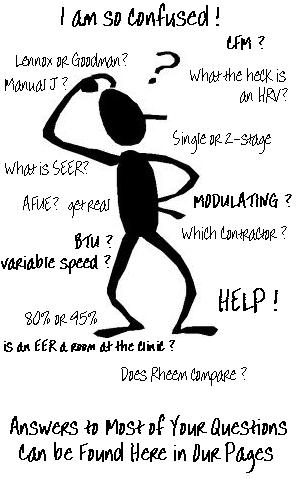|
THE HVAC PURCHASER'S DILEMMA
| |||||
|
|
- The quality of the installation is very important. If you go with the cheapest bid, you will probably get a bottom quality installation. Especially if there is a wide cost difference between your bids, the lower bids are cutting corners somewhere. But also be careful of price gouging. Heating and air conditioning companies need to make profit just like any other business! You need to find the balance between the two. Don't be afraid to question your prospects to help with weeding out the rotten apples.
- Top end equipment and installation materials should always be considered. Higher efficiency equipment from all manufacturers tends to be more dependable, as well as, saving dollars at the meters. Those service calls to keep lesser equipment running can cost considerably more, over time, than the initial installation cost for the better eqipment.
- Operation cost. The higher the efficiency, the less money escapes your wallet on a monthly basis. Lesser quality/efficiency equipment will cost a lot more to operate during it's lifetime, and they tend to fail sooner and more often. Service calls!
A comprehensive bid/quotation should detail the following:
- Copy of the calculated hvac design requirements following manual J, D, and S protocols.
- The scope of work to be performed.
- The recommended equipment to be installed.
- Estimated installation time.
- Warranties: Installation and Equipment.
- Exclusions: Work that the contractor will not be providing or to be provided by others.
- Price and payment terms.
- Contract mutually agreed upon by both parties.
- Installation and end-user manuals for all equipment installed.
If the Hvac design is not followed or a sub-grade installation is provided, the system will perform poorly. This means your equipment may run constantly, using up electricity, costing you a lot of money and still not providing the comfort levels you had hoped for. Also, the harder your system must work, failure is more likely, and premature equipment replacement inevitably must follow.
A typical accepted low bid installation is commonly seen where a single indoor air conditioner is installed where 2 separate systems would have been called for, had a proper Manual J design been undertaken. The single system is cheaper to buy than the double system, cheaper to install, and certainly cheaper in material and equipment costs. The cheap guy gets the job because the customer sees a savings. His installation is sub-par, he has to cut corners wherever he can to show a profit on the job. The result is complaints about warm and cold spots throughout, the clients are uncomfortable, humidity is not controlled, and operating costs are sky high. Soon the unit breaks down and after numerous service calls, the inevitable decision must be made to scrap the inferior system and start over again.
Had the more expensive multiple system been installed originally, the system would provide the promised and expected comfort levels, no hot or cold spots, no unexpected breakdowns occur, and money is not thrown away on inefficiency. Overall a quality installation can ensure this scenario with proper annual maintenance.
Maintenance
Comfort system maintenance should be performed, at least, semi-annually. This allows the unit to work at full efficiency. Filters, air conditioning evaporator coils, and heat exchangers can become blocked, which will result in the system not working efficiently. The unit may then fail and cost increased utility bills, and worse.
Many companies offer annual maintenance contracts. Maintenance is provided at the beginning of each winter and summer season. Some maintenance certainly can be performed by the homeowner, such as filter changes, regular cleaning of equipment surfaces, and blowing debris out of the outdoor condensing unit.
Other Hvac Design articles:
Why Design?
Do I Really Need a Manual J Calculation?
Benefits and Uses of a Manual J and Manual D for the Homeowner, Builder, Architect, Hvac Professional, and the Handy Do-It-Yourselfer
ACCA Manual J Residential Load Calculation: The Only Way to be Sure.










 The HVAC DESIGN
The HVAC DESIGN


